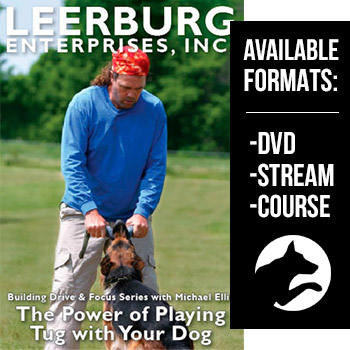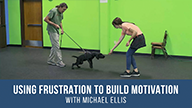The Motivational Steps to All Dog Training
Ed's Disclaimer: I wrote this article back in 2001 and recently (2013) reviewed it. Considering the fact that I wrote this article, I can take the liberty of saying that it's RUBBISH. It's old school dog training.
I had not read it in 12 years and after my review, I cringed. My first inclination was to immediately delete it off our website. I thought it should have been gone a long time ago. But after a little thought I decided to leave it and add this disclaimer.
I have been training dogs for over 50 years. If you love dogs like we do, you will figure out that dog training is a journey. If you have an open mind, you will figure out that you will never know everything about training dogs. As you gain experience you will learn new methods, you will change your mind about old methods, and you will become a better dog trainer. So with that said, I know in my heart that the methods I discuss in this article are wrong.
There is a generalized approach to training any exercise in dog training. This begins with the trainer understanding that most dogs need between 30 and 50 repetitions on any exercise before the dog has learned it. By contrast a human only needing 7 repetitions.
If a dog develops a problem that you need to fix in training it is going to take many more than 30 reps before the dog adopts the new behavior. This is why I always explain to people that it is easier to take a little more time to train an exercise the correct way the first time than it is to go back and fix problems.
There are three main segments of training to teach a dog any exercise. This applies to obedience and all other areas of training as well (i.e. protection work, agility, etc.)
1. The Teaching Phase
In the first section we must teach the dog the meaning of the commands for the exercise. This is done through positive motivation. In other words, we find something that the dog really likes (i.e. a ball or food). We then show the dog (without corrections) that if it does what we ask it will get his reward. The challenge for every trainer is to determine small enough training steps that the dog can understand what you are trying to teach him. If it seems that he simply cannot grasp what you want then you have to break the step into smaller steps. Learning how to do this requires experience and/or a person who really thinks about every aspect of training, (these are rare birds).
2. Learning Through Intermittent Success
This second stage is where we teach the dog that he does not get success for his drive goal (i.e. his food or toy) on completion of the exercise every time. The goal of this stage is to teach the dog that he never knows when the reward will come. This builds drive. An example of this is in the heeling training. Initially, (after a dog has learned to sit by the handlers side and focus on his face), the dog is rewarded after one step of heeling. When he will consistently stay with the handler (in drive and with focus) for one step, the steps are increased and decreased in random order before the dog gets his reward.
So he may get rewarded after 3 steps, then after 5 steps, then after 7 steps, then after 2 steps, then after 1 step, then after 9 steps. With the goal being that the dog needs to remain in drive and keep focused throughout the exercise before it gets it's toy or food.
If it breaks focus, the exercise is finished and there is no toy or food for the dog. You must start all over and the next time, back the reward up a few steps. It must become clear to the dog (in this stage of training) that for him to get his reward, he must do what is asked.
3. Learning Through Conflict
The last stage of teaching an exercise is to teach (PROOF) an exercise by creating an unclear situation for a dog. We force him to think about what he must do. We want to create a situation where the dog will make a mistake and then show him that he must think before he does something or he will get corrected and not reach his drive goal (the toy or food). This stage of training teaches a dog control over himself. Some dogs go so high in drive that they stop thinking. This step in training (Learning through Conflict) is how these dogs learn to get a grip.
An example of this is when the learning routine is changed just enough to create a mistake. In heeling this can be a speed change in the walk. It can be a right turn or left turn. In training the "Bark and Hold" in protection work, the dog is sent to the helper who is sitting on the ground with two sleeves on, or he is sent into a small building (instead of the blind on the training field) and expected to do a clean bark and hold without biting.
Some form of compulsion is almost always used before an exercise has been fully trained. It is most important that the formula for compulsion is always: DRIVE - COMPULSION - DRIVE.
Simply put, this means that we try and set up our training to begin an exercise in drive (the dog is crazy for his drive goal and trying very hard to do what he can to get it). When it makes a mistake, while in drive, we apply compulsion (corrections). Compulsion takes drive out of the dog. Our final step is to then finish the exercise by putting the dog back into drive, hence DRIVE - COMPULSION - DRIVE.
A perfect example of this is seen in the heeling work. The dog is in drive (he knows he will get his ball after walking a certain number of steps - he doesn't know how many but he knows the ball is coming). The trainer decides that this session is going to require 15 steps before the dog gets his ball. At 10 steps the dog breaks the heel and bounces in front because he cannot stand it any longer, (in his mind he wants his ball and he has heeled long enough), the trainer administers three sharp jerks on the leash to get the dog back into the heel position. This takes some of the drive out of the dog (he is now thinking this is a little less fun than he thought). But as soon as the dog takes 2 or 3 steps in the correct heel position the handler drops the ball and plays with the dog.
After doing this 30 times, the dog will learn that every time I get a correction I am going to get my ball if I do what is expected. When that light bulb goes on in our dog's head we will see dogs go up in drive with corrections. They will also mind when they go up in drive because they know that unless they do what is expected, the next corrections will be harder.
New trainers can use this formula (Drive-Compulsion-Drive) to determine how hard to correct their dogs. Corrections should never be so hard that the handler cannot bring his dog back into drive. Corrections will always bleed drive out of a dog, but if the correction is so severe that the dog will not go back into drive, then the level of that correction was too hard for that particular dog's temperament. Hence the terms HARD DOGS and SOFT DOGS. A "soft-dog" requires a very light correction. If the correction is too hard for a "soft-dog" it will not recover quickly enough to go back into drive for this training session. On the other hand, a "hard-dog" recovers very quickly from a correction and will easily go back into drive after a stiff correction.
The new trainer needs to learn that he must control himself and the levels of corrections he administers in training. He will never become an effective dog trainer unless he can accomplish this one goal. Learning to work with the Drive-Compulsion-Drive formula is probably the most important thing any trainer can learn in dog training.
When a dog goes through the process properly, it will actually go up in drive after it gets corrected because it has learned that it is now going to be put in a situation where it gets it's drive goal.
If you have read this article and are interested in the way we think today, I suggest you read The Theory of Motivation in Dog Training.











Ask Cindy.